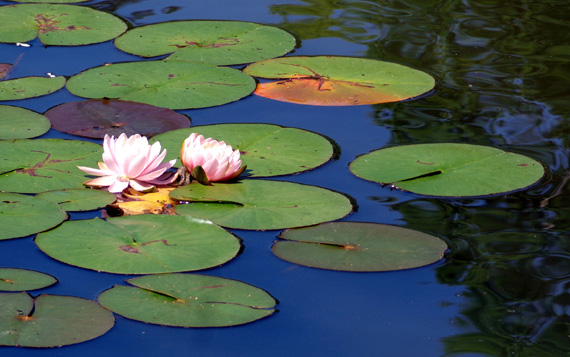During our thirteen years of extended and full-time RV travel we've
sought out cooler climes in the summer -- going farther north in
latitude and/or higher up in elevation -- and warmer temperatures
in the winter.
We usually timed it about right, although we occasionally ran into colder
or hotter temps than we anticipated, like this May snowfall in Colorado
Springs one year:
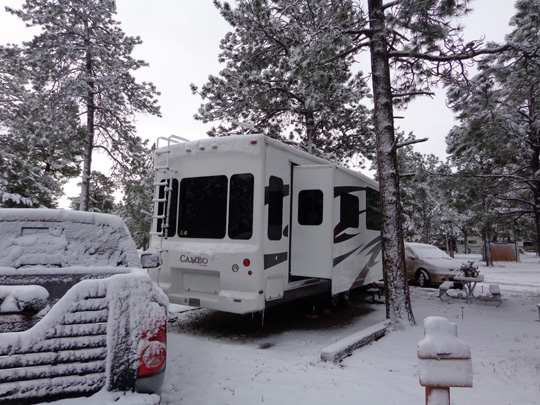
Our quest for eternal spring weather is what I've fondly referred to as the
"Dandelion Time Warp" for many years. We aren't fond of temperature
extremes and Jim's a total snow-phobe after living in Illinois and
Montana for 55 years.
The dogs and I like a little snow more than Jim does every now and
then:
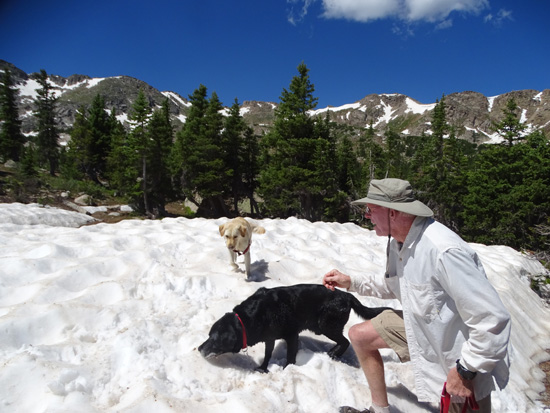
Warm enough for shorts in early
July, 2016 in Leadville, CO but high enough altitude for some
remaining snow banks along the
trail at Windsor Lake; Jim looks like he's having fun, doesn't he??
We've always enjoyed our summer destinations to the mountainous west,
Alaska, New England, and the Canadian Maritimes more than our winter
ones to the far southern tier states because the terrain and scenery is
so much more fun for us where there are mountains and canyons to explore.
We're more in our element in the mountains than in coastal areas.
This picture of Jim and Casey from early July, 2016 at Windsor Lake
brings back great memories of the two months we spent at very high
altitudes in Leadville, CO:
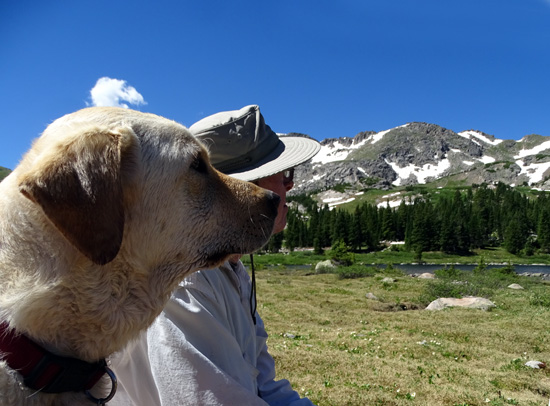
We get tired of living in arid desert terrain for very long, as
in Arizona and southern California, and we lose our hill conditioning
for hiking and cycling when we've spent our winters in southern Texas,
the Florida panhandle, or the southeast Georgia coast. We go there
primarily for the warmth.
But to find our preferred temperature range this winter we headed back to the St. Mary's, GA
area again in late October and spent almost five months at Kings Bay Sub
Base. This was our fourth time snow-birding at Eagle Hammock RV Park and
our longest time ever to sit in one spot since we began this RV
adventure in 2004.
Far southeastern Georgia -- this campground is only a mile as
the crow flies from the Florida border -- is certainly not a bad place to
spend the winter but the inertia and flat terrain wore on us by the time we left.
We were ready for a change by the end of March. Even if we hadn't purchased a
house up near Atlanta we would have moved farther north because Kings Bay was
literally heating up and we sought cooler temperatures.
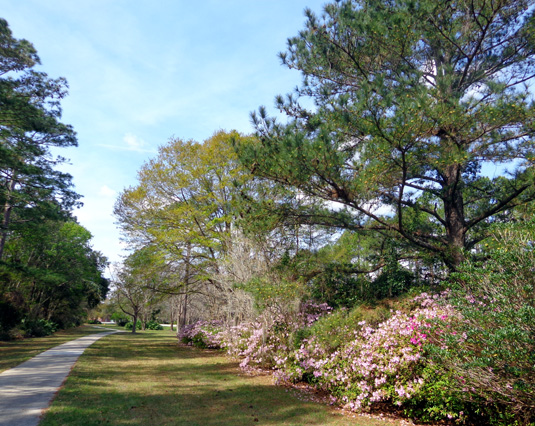
Pretty azaleas and green leaves
along the bike path at Kings Bay in February
This entry is a summary of the time we spent at Kings Bay from late
October until we moved farther north on March 26. I've written
about camping at Kings Bay several times in the past; this entry
will have mostly new photos from the RV park and sights on base.
WELCOME TO EAGLE HAMMOCK RV PARK!
Eagle Hammock is open to active duty personnel, military retirees,
National Guard, Reserves, DOD civilians, and 100% Disabled Veterans.
Guests are allowed from April to October when the temperatures are
hotter and the campground isn't as crowded.
It is a popular winter destination, especially for folks who live
farther north.
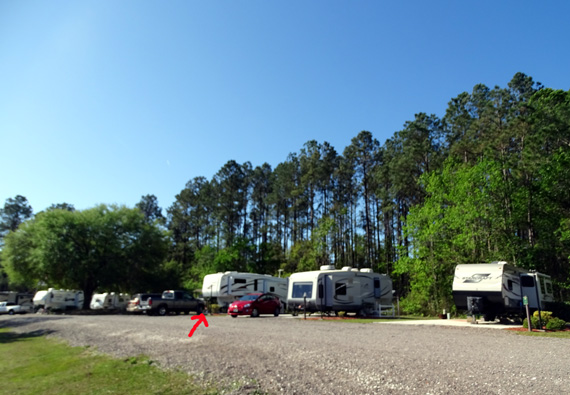
Some of the lakeside sites
-- what's not to love about green trees and grass in mid-March?
The arrow marks our car, truck,
and Cameo 5th-wheel coach.
During each previous winter at Eagle Hammock we've spent all or
most of the time in one of the ten lakeside campsites. Although they cost a
little more than the back-in and pull-through sites in the main part of
the RV park, they are larger, quieter during the day, darker at night, and right
by Lake D, which is very scenic and has lots of birds.
When we spent several months here two winters ago we thought we had
one of the best sites in the campground, the first lakeside site next to
the entrance. It was very convenient to the office and had a good WiFi
signal. No one was on our door side; we had a big grassy front yard and
"gatekeeper" position where we could see everyone coming and going:
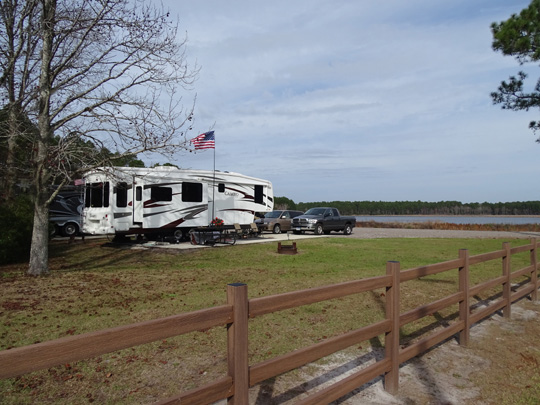
Our almost-ideal site the winter
of 2014-5
The downsides were the distractions and noise with all that coming
and going, and not being able to see the lake very well
from our patio or living room windows even though our site was close to shore.
Lake D was very low that year and we saw more vegetation than water.
This time we were able to get into what we consider the best lakeside
site, the one we've never been able to score until this visit because staff and
campground volunteers have occupied it previously. It's far enough down
the row of lakeside sites to be very quiet and have a great view of the
lake from both inside our camper as well as out on the patio:
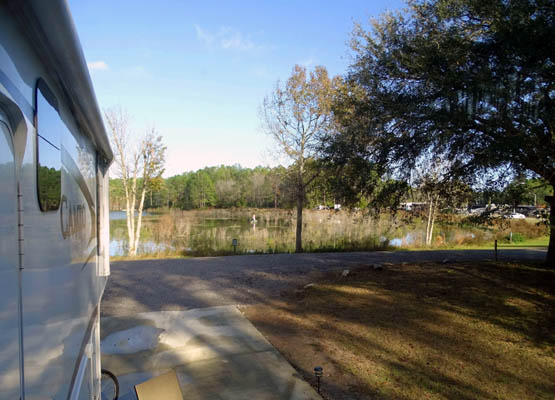
This year's nice view from the window beside my
desk
In addition, there is a huge live oak tree shading the patio much of
the day, tall pines and hardwoods in a band of trees behind us, and at least
100 feet of grass between our doorside and the next site = lots of
shade, privacy, and room for the dogs.
Here are a couple pictures looking toward our current site:
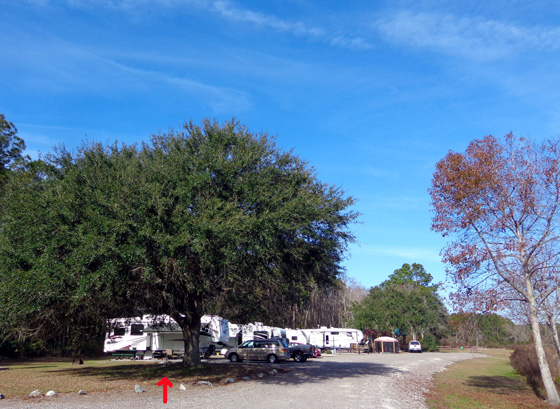
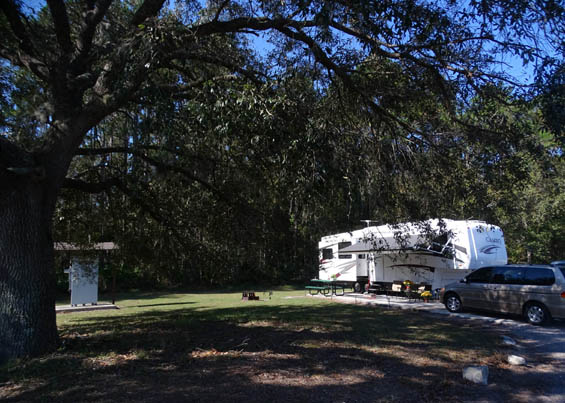
We put that great big live oak tree to good use the whole time we
were there -- even at night.
While we were at the Blue Angel Navy Recreational Area in October we
discovered LED laser lights that folks use at Christmas and other
holidays to project patterns on the sides of their houses or other
objects. One of the couples lit up the tall trees surrounding their site
with pretty green lights and we were mesmerized -- how did they
do that??
Not one to be shy, I went up to their door and asked them!
They graciously showed me their laser light projector and described what it can
do. I went back to our camper and did some online research, learning
that there are all kinds of
light projectors available -- but I wanted that model because I
could see what it could do to make the right kinds of trees look
fabulous at night.
The next day we left Pensacola and drove to Kings Bay. After we got
set up in the site at Eagle Hammock with the huge
live oak tree I went to Walmart and got the same projector the other RVers
used, a Star Shower Motion model:
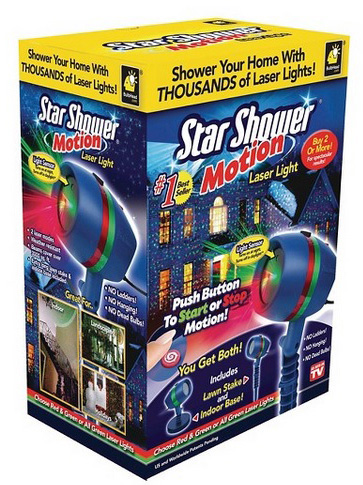
You can get it at other local stores or online. We got a second one a
couple weeks later at a lower price at Target when they went "on sale."
The Star Shower has both green and red lights that
can be projected in either a static or motion display. Green showed up best
against the leaves and branches of the live oak in the dark and there was
enough breeze coming off the lake most nights to leave the projector in
the static position all winter. The breeze made the lights dance like fireflies.
I loved the twinkling effect and so did our neighbors and other folks who
walked by. Unfortunately, I wasn't able to get any really good photos of
the lights (or any of the full moons we observed) with no tripod;
the lights look white but they were green:
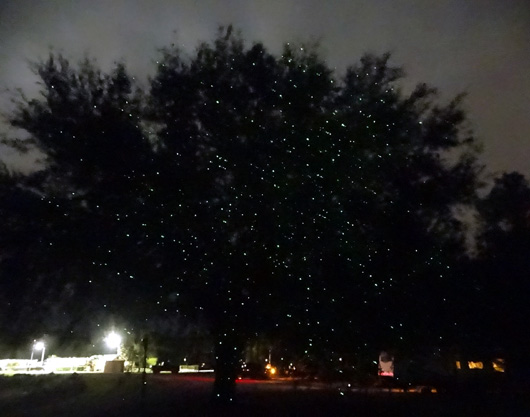
I shone the second light projector on both the tall trees in the back
and on the side of the camper but the lights weren't as pretty as on the
oak tree with its dancing leaves. So we put the second projector away to
save for the time the first one quits working.
MORE ABOUT THE CAMPGROUND
Eagle Hammock has sixty full hookup sites with generous concrete pads
and patios surrounded by grassy areas and attractive landscaping. Tall
trees surround the campground, offering shade for people and habitat for wildlife.
The main section of the RV park has about fifteen long pull-thru sites and
about thirty-five back-ins. The ten lakeside sites are all back-ins but they are
so wide they are relatively easy to maneuver. They are plenty long for
the largest modern RVs and one or two vehicles in front:
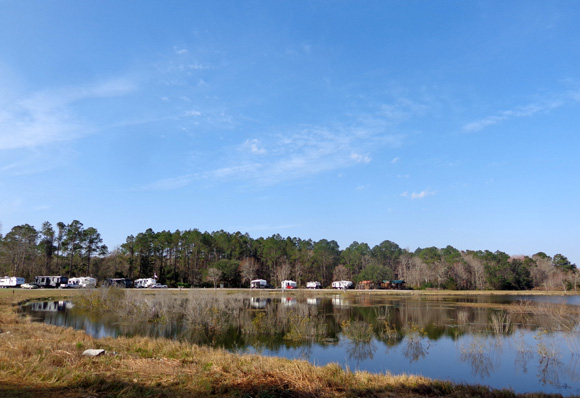
View of the sites next to Lake D;
two brown cabins are to the right of them.
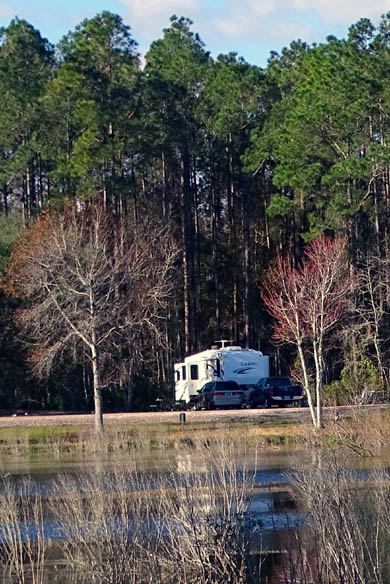
Close-up of our site near the water
Utilities include 50-amp electricity, water, sewer, and either cable
TV in the main part of the RV park or converters for satellite in the
lakeside site for visitors like us who don't have our own satellite dish.
Daily and monthly fees are very reasonable and are based on the
location of the site and status of the people occupying it (prices for
military members and retirees are lower than for civilians). Our monthly cost
for a large lakeside site was a very reasonable $570 for full hookups plus "free"
laundry and WiFi, although the WiFi signal
isn't as good in this site as last time because we're farther from the
office. Jim was able to use the campground's WiFi more than I was but we
have our own private signal with Verizon when I needed it for my widescreen laptop.
There are also two nice furnished prefab cabins next to the last
lakeside RV site. They each have a living area, kitchen, bedroom,
and bathroom; one also has a loft. They are
reasonably priced at about $60/night and stay booked most of the time
in the winter:
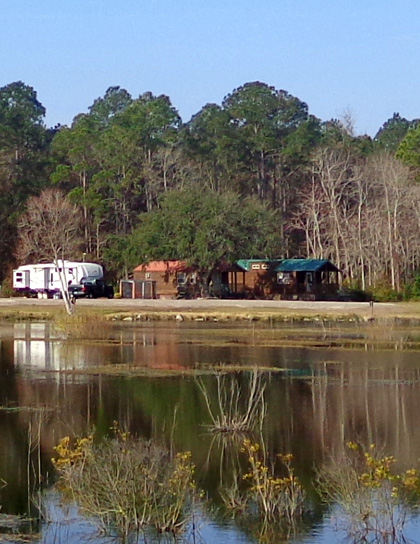
One reason I like the lakeside row of campsites is its proximity to a
photogenic pier jutting out into the lake. I loved taking pictures of it
when large birds roosted there and on misty mornings:
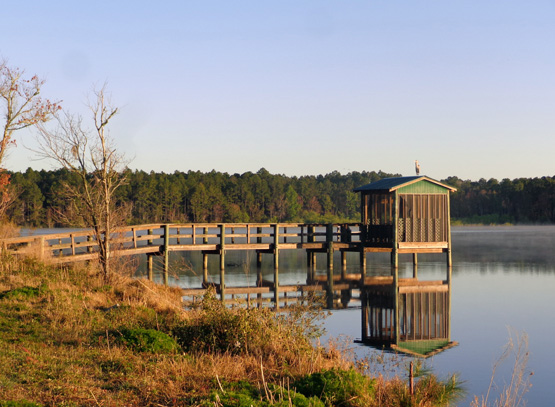
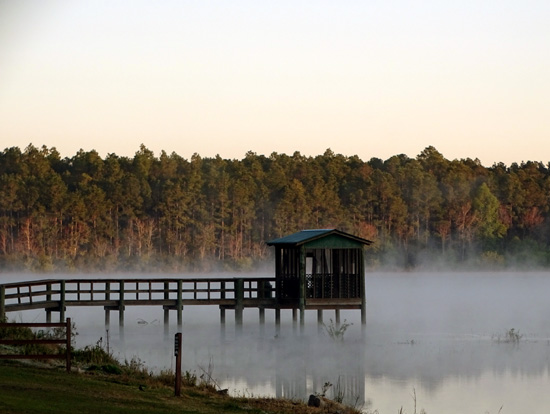
In addition to the office, Eagle Hammock has a community building
called The Nest in the center of the main RV sites with a laundry room,
restrooms, kitchen, and two rooms for gatherings.
There are lots of planned and spontaneous activities for people to
socialize all during the winter months when the RV park is full.
Because we had so much going on with medical appointments and
house-hunting this winter we participated in fewer group activities than
during our previous stays in this RV park. We did attend a few potluck dinners,
wine & cheese tastings, ice cream or dessert socials, and special
events and met even more people while walking through the campground.
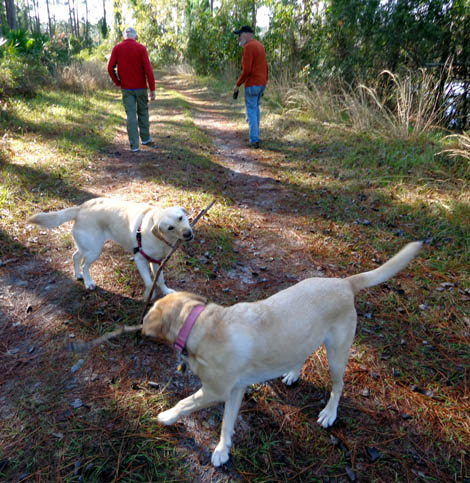
Jim and Gordon walk along Lake D
while Casey (L) shares a stick
with her best buddy this winter,
another yellow Lab named MacKenzie.
KINGS BAY SUB BASE
Kings Bay is a beautiful base with lots of things to offer not only
retirees like us, but also the younger active duty families who live and work
there -- lots of green grass, trees, and flowers; numerous
ponds and lakes; plenty of bike paths and quiet streets to walk, run, and
cycle; some dirt trails to explore; a large dog park; veterinary clinic;
ball parks; tennis courts; golf course; children's play areas; theaters;
restaurants; and convenient services we often used like the commissary,
NEX, gas station, fitness center, and Post Office.
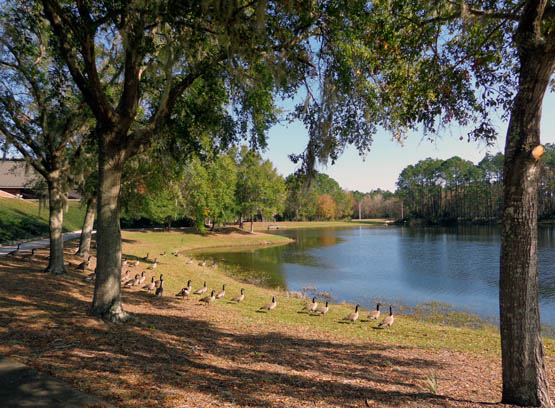
Geese gather around one of the
many lakes on base.
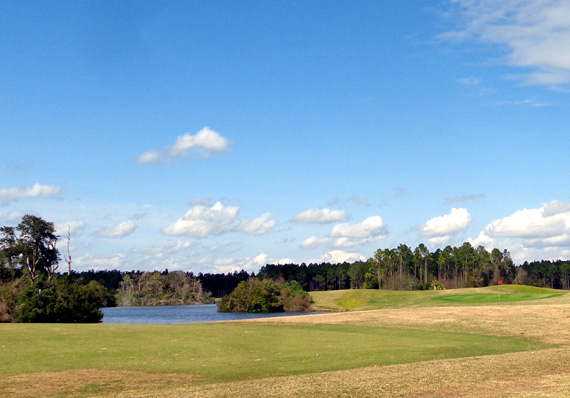
Scene from Trident Lakes Golf
Course, named after the Trident nuclear subs at Kings Bay
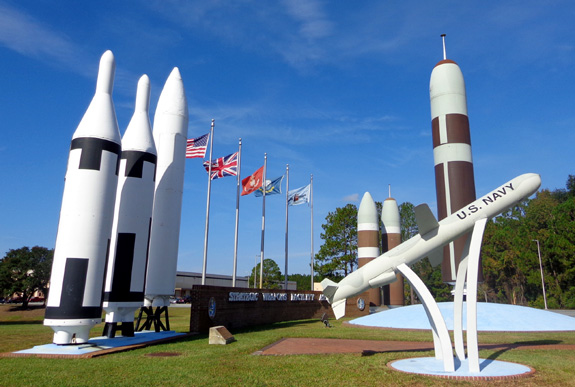
The entrance to the Strategic
Weapons Facility buildings is near the RV park.
Not sure whether to feel more
safe or less safe staying on military bases!
Nearby off-base are lots of medical facilities, including a hospital,
veterinarians, Walmart, Publix, Lowe's, and plenty of other businesses
and restaurants.
We drove
down to Jacksonville, FL (about 30 miles) when we wanted to
shop at Sam's Club, PetsMart, or Home Depot but we mostly tried to avoid freeway
and city traffic. When Jim had his
partial knee replacement in December and I had cataract surgery in
January and February, we drove a little farther to Brunswick, GA instead
of fighting traffic the other direction in metro Jax.
There are plenty of interesting places to visit in the vicinity,
including the Okefenokee Swamp and the Golden Isles (St. Simons, Jekyll,
and Sea Islands). We've been there previously and didn't return this winter.
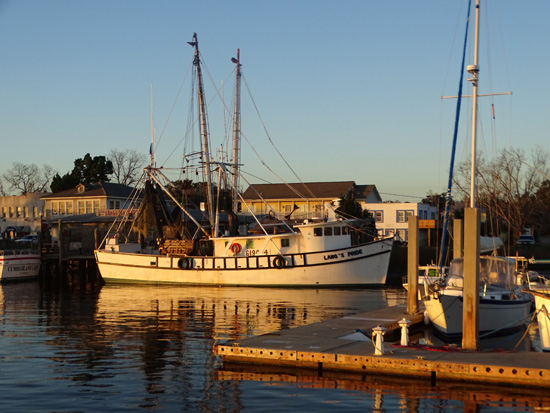
Dock at St. Mary's at sunset
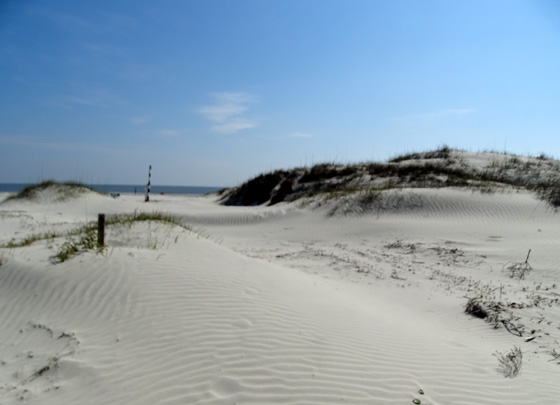
Fine white sand dunes on the
Atlantic side of Cumberland Island Natl. Seashore
We were happy to stay closer to "home" this time and just enjoy the
remnants of the old sugar mill, the pretty little seaport town of St.
Mary's, and beautiful Cumberland Island National Seashore, all of which
are adjacent to the east, west, or south sides of the base.
I'll have lots more photos of St. Mary's and Cumberland Island in the
next entries.
FLORA & FAUNA
Kings Bay/St. Mary's is a beautiful place to spend the winter months,
especially since fall is very late and spring comes very early this far south.
This year spring came even earlier than previous times we've stayed here.
Although there were a couple sub-freezing mornings in early January,
most of the time from November to March was warmer than average, much nicer than
the cooler, wetter winter we had here two years ago.
Early spring flowers like forsythia and daffodils were blooming at
Kings Bay in mid-January. Azaleas and laurels, yellow jessamine, and bright red
winged seed pods on maple trees were out by the end of January.
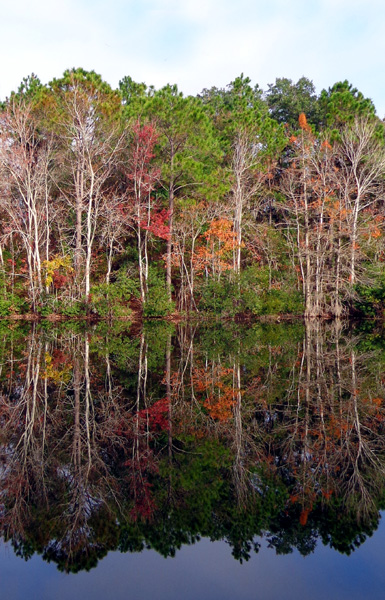
These fall colors reflected in
Lake D in mid-January
collided with new spring flowers at the same time.
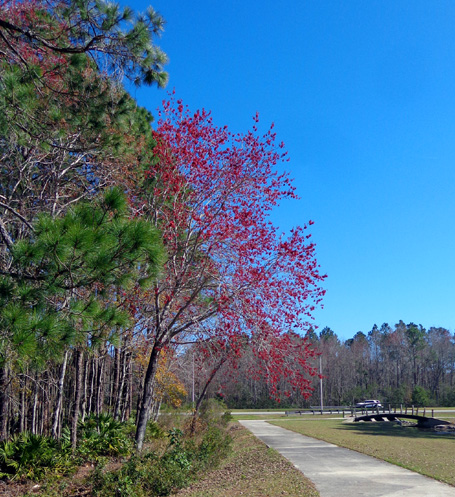
This looks like a flowering tree
but it's a maple with red winged seed pods in early Feb.
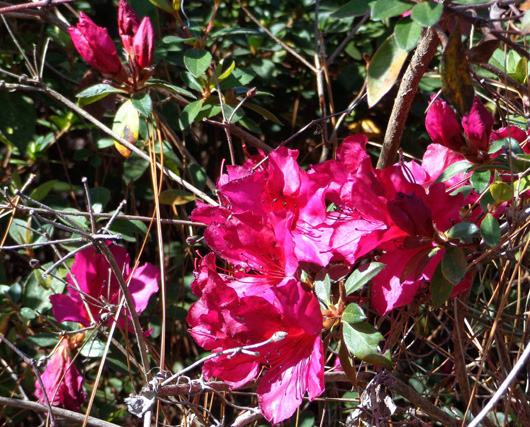
A variety of colors of azaleas
were blooming by the end of January this year.
Little green leaves were popping out all over by early February, and
the redbuds and other small flowering trees went nuts then, too. By the
time we left in late March it already looked like summertime.
Because the water in Lake D was so high this year I didn't see nearly as
many alligators in it as the three previous times we've been here.
The large ones are easy to spot when they lie on open banks sunning themselves, as
in this photo from two years ago:
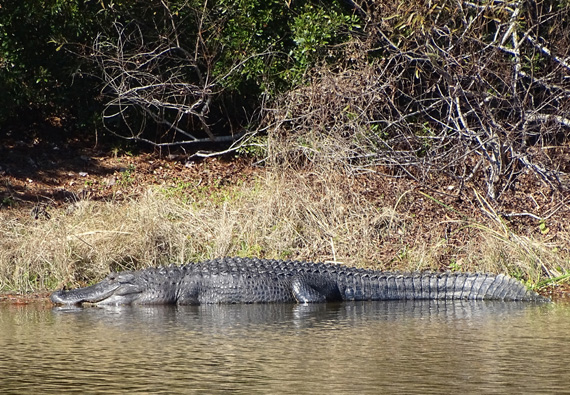
With Lake D's banks completely covered with water all this winter I never
saw any eight- to ten-foot 'gators sunning themselves, or even the big turtles
we've seen before. I occasionally spotted the sawtooth silhouette of a larger 'gator
swimming in the water.
This year we did see a few young 'gators and turtles sunning
themselves on the banks of smaller ponds on base:
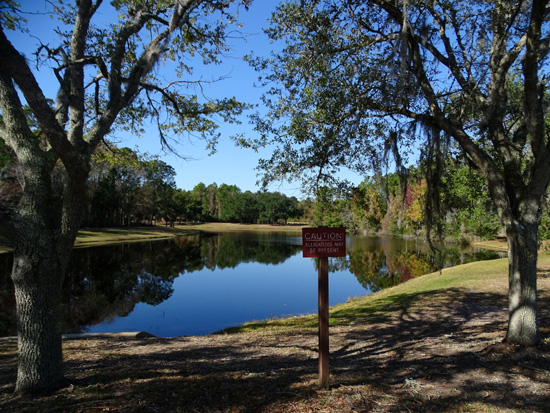
Every lake and pond on base has
signs like this warning that alligators may be present.
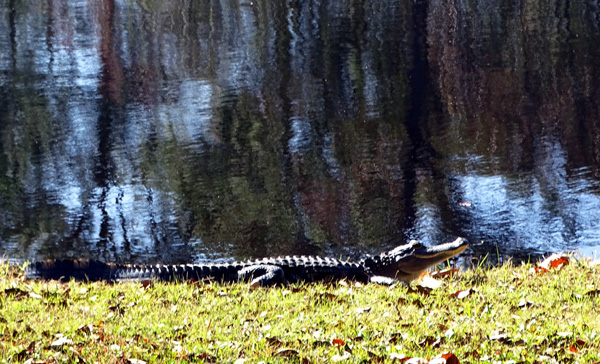
I watched this adolescent 'gator grow
during the five months we were at Kings Bay.
It was about four feet long when
we left in March.
I asked the campground maintenance guy where all the alligators are;
he's been here before and knows about them. He said most of the large
alligators in Lake D were "relocated" because the previous winter
(when we were in AZ and not here) some of the campers apparently fed them
and they became a nuisance.
That's a shame, because it was very cool to spot them across the lake
on many of my hikes.
There were just as many water birds at Lake D this winter as before, though, and
a species new to us kept me fascinated all winter --
anhingas.
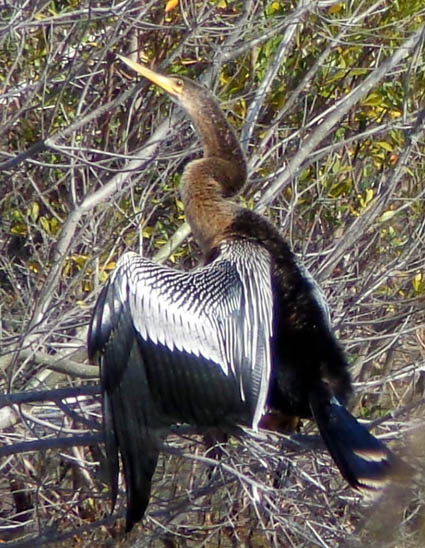
These are large shore birds that are similar to comorants but one of
our neighbors told me the true identification. The silver patches on the
anhinga's wings are striking when the bird is sitting on a branch with
its wings spread to dry.
At least one pair of anhingas took up residence in the lake near our
site this winter. Every day I looked for them and took pictures from
different angles, often with their wings spread:
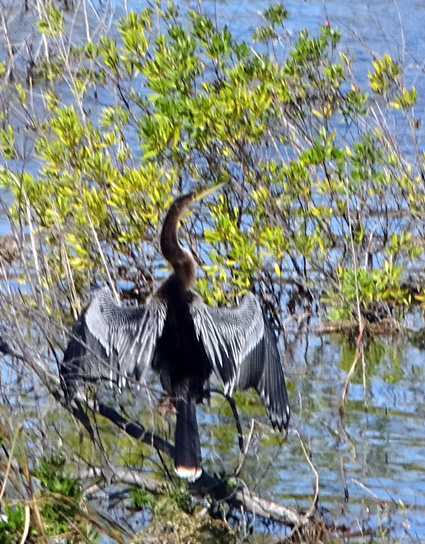
There were also a lot of egrets, herons, ducks, geese, and other
birds to watch at Lake D and the other bodies of water around
the base:
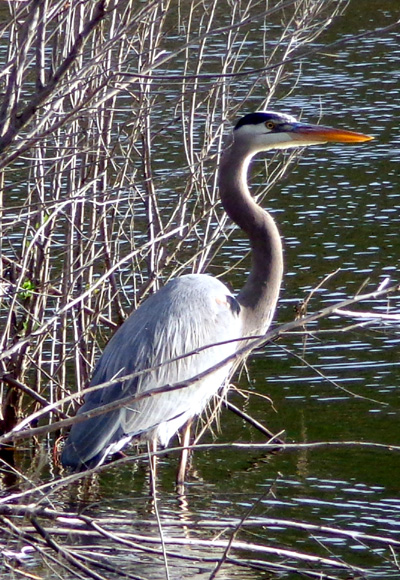
I'm pretty sure this is a type of
heron.
Other common critters on base include armadillos, rabbits, squirrels,
and deer. It was fun to see them as we walked, cycled, and drove around the base.
This curious (or blind?) armadillo came right up to my bike when I was
riding near the golf course one morning and stopped to take its picture:
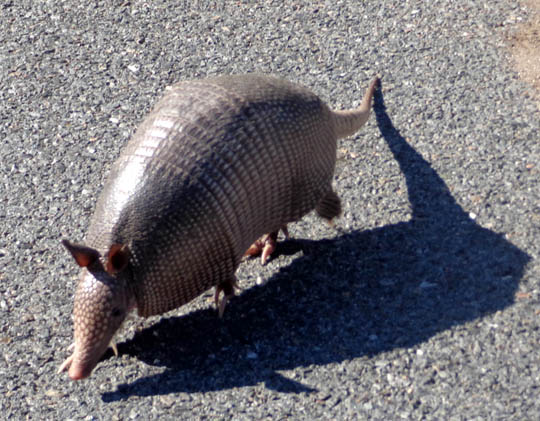
I guess it's no wonder you often see them smooshed on
roads in southern states from one coast to the other; they
have even less road/trail savvy than squirrels.
[We were more than surprised this summer to discover that armadillos
live at least as far north as Peachtree City, which is not that far
south of Atlanta! I never heard of them in
the Atlanta area when I lived in the NE metro area from 1974-1999. Now
we have at least one that comes under the fence and digs in our yard at
night.]
STAYING HEALTHY
Although neither of us can run any more, maintaining our fitness is
just as important to us as we age -- maybe even more so --
as it was when we were training for 100-mile trail running events. Every day
during the winter we got out to walk and/or ride our bikes solo or with the
dogs, on base and off.
There are miles and miles of paved bike paths and roads on base that
are safe to ride and very scenic, passing by the numerous lakes and
ponds, the Trident Golf Course, tennis courts and ball fields, through
forested areas, attractive base residential neighborhoods, and through
parts of the working areas that aren't high security.
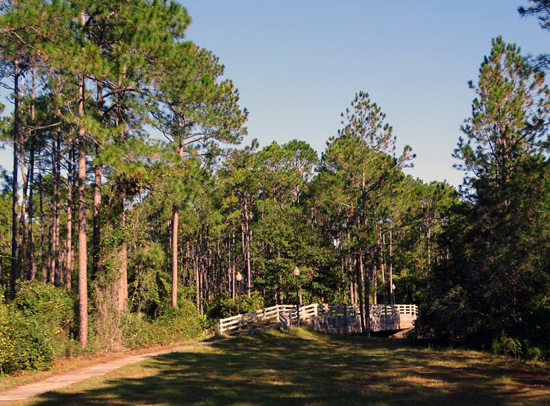
I enjoyed walking on the wooded dirt and grass trails around Lake D
even more than the paved bike paths because they were quieter, closer to
the lake, and I could let the dogs run off-leash. I rarely ran into
anyone on the dirt paths.
We both rode our bikes a lot of miles on and off-base. When we wanted
more variety we went out the gates and rode down to the little town of
St. Mary's, which has a scenic port, pretty parks, museums, restaurants,
and lovely historic houses.
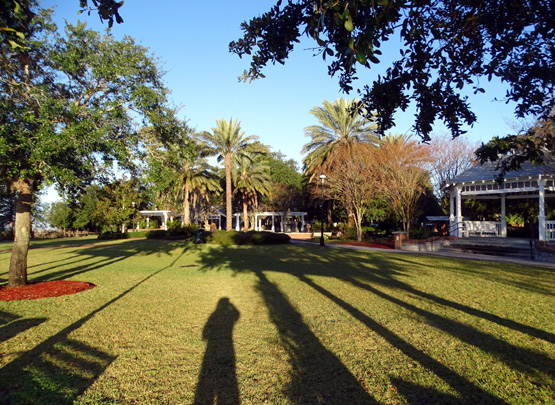
Early morning shadows in the park
by the bay in St. Mary's
My two longest and most interesting hikes this winter were at
Cumberland Island National Seashore, just off the coast to the east of
the submarine base. I'll write about it in the next couple of entries.
The only downside to walking, hiking, running, and cycling in this
area is how flat it is.
Now some people see that as a big advantage, but we both missed the
more hilly terrain we prefer. When we moved to Peachtree City in April
and hit the hilly paths here, we had to train our muscles for hills
again.
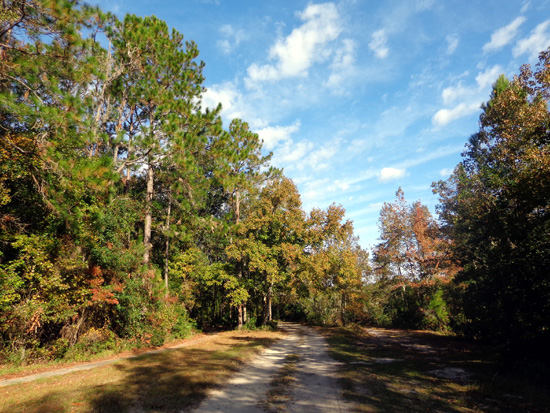
We spent as much time outside as possible at Kings Bay since the
weather was mild most of the time.
When we had to be inside we were on our computers a lot or watching
TV. Jim got me hooked on the weird and popular Netflix series called
"Breaking Bad" and I ended up watching all seven seasons of the
shows over several weeks. Jim's seen it before and enjoyed watching it
again. There are so many twists and turns to the plot that he got more
out of it the second time.
Like most folks, as we get older we also have more things going wrong
medically. We've been fortunate to find good medical providers for most
of the body parts we needed to maintain or repair during our thirteen
years of RV travel.
This winter Jim had a partial knee replacement for the knee he
injured while cycling several years ago. It was the wreck that ended his
running career. He did his research and found a competent orthopedist
(Dr. Beau Sasser with Summit Sports) in Brunswick, GA who does
computer-assisted partials. His surgery in December and recovery went
well. I'll write more about this after I have my own knee replacement in
September so I can compare the two experiences.
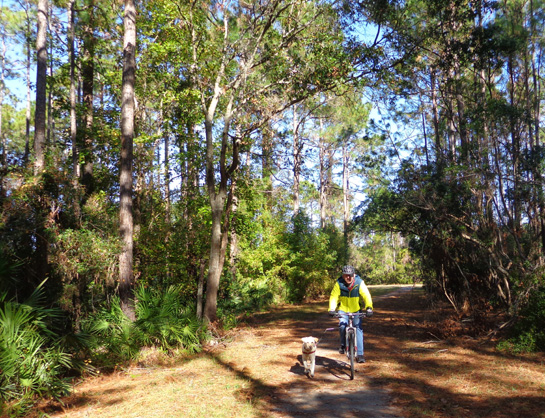
Above and below: Jim and Casey
ride/run at Kings Bay right before Jim's surgery
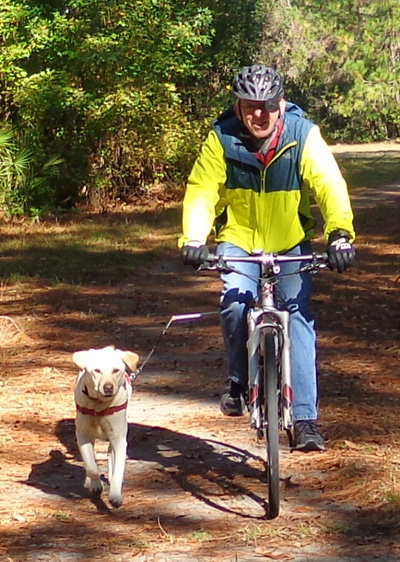
The other major medical repair was cataract surgery in both of my eyes.
I've known for several years that cataracts were gradually developing so
I wasn't surprised when the optometrist I saw in December for my yearly
check-up said I should get it done. I thought I just needed new glasses
but my own lenses were getting cloudy enough to warrant the
surgery.
I also chose a skilled surgeon in Brunswick, Dr. John Imhoff with
Southeast Eye. I opted for the computer-assisted procedure, which is
more accurate than manually cutting the cornea. Surgery was quick and
painless for each eye (done separately). The only "problem" was
not being able to see
clearly for three weeks between surgeries because I couldn't wear my
old glasses any more.
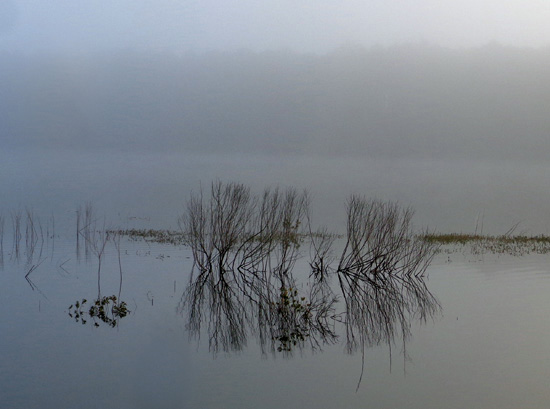
My vision wasn't this
cloudy! This is just a cool scene of leafless shrubs in Lake D one misty
morning.
Seriously near-sighted all my life, I'm very happy with the results
because I can now see better than ever before with my new intraocular
(implanted) lenses and can use inexpensive over-the-counter reading glasses for the
computer and reading things close-up.
HOMEWORK
What kept us the busiest all winter was researching a new home base
and specific houses.
In the introduction to this year's journal I cut to the chase and
said we bought another house this spring, after living in our RV
full-time the last three years and for eight to nine months of each of
the previous ten years. I'll go into more detail about the
reasons why we decided we need a home base, and how we chose the
particular location and house we bought, in subsequent entries.
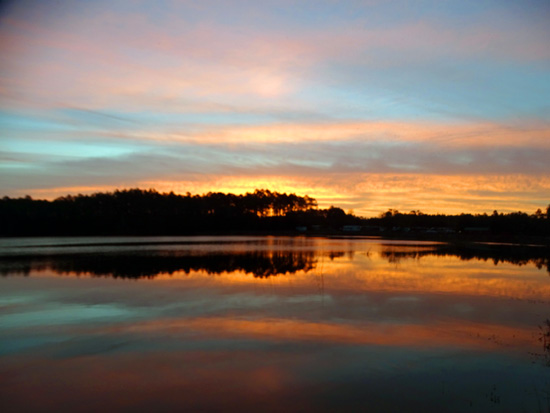
Sunset over Lake D
For now, I'll just say we spent considerable time and thought on this
process during the fall, winter, and spring, from researching locations
and specific houses online and in person to purchasing some furnishings
and equipment before closing while we were still at Kings Bay.
It all took a lot of time and may have aged us a few more years but
we're pleased with our decisions.
Next entries: scenes from St. Mary's, GA and Cumberland
Island
Happy trails,
Sue
"Runtrails & Company" - Sue Norwood, Jim O'Neil,
Cody, Casey, and Holly-pup
Previous
Next
© 2017 Sue Norwood and Jim O'Neil
